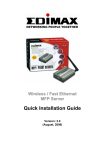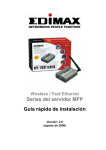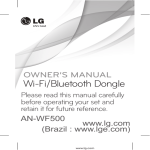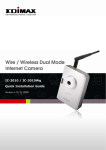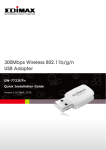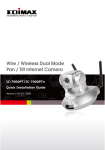Download Edimax Combo Print Server Installation guide
Transcript
Fast Ethernet Combo Print Server Quick Installation Guide Version: 1.0 (November, 2006) Multi-Languages QIG in Driver CD ================================================== Český: Anglického průvodce rychlou instalací aleznete na přiloženém CD s ovladači Deutsch: Finden Sie bitte das englische QIG beiliegend in der Treiber CD (German) Español: Incluido en el CD el QIG en Ingles. Français: Veuillez trouver l’anglais QIG ci-joint dans le CD driver Italiano: Incluso nel CD il QIG in Inglese. Magyar: Az angol telepítési útmutató megtalálható a mellékelt CD-n Nederlands: De engelstalige QIG treft u aan op de bijgesloten CD Polski: Skrócona instrukcja instalacji w języku angielskim znajduje się na załączonej płycie CD Slovensky: Anglického sprievodcu rýchlou inštaláciou nájdete na priloženom CD s ovládačmi. Português: Incluído no CD o QIG em inglês. Русский: Найдите QIG на анлийском языке на приложеном CD Product Introduction Thank you for purchasing Edimax Combo Print Server. This Print Server allows you to share a normal USB printer or GDI/Host-based USB printer to the network users. GDI printer is a printer that has built-in support for Windows Graphical Device Interface (GDI), so it is no need to convert the output from Windows to another format such as PostScript or PCL language. GDI printers are sometimes called host-based printers because they rely on the host computer to rasterize pages. Because of that, almost none of Print Servers in the market can support GDI printer network sharing. This GDI Print Server implements a special technology, which allows it to communicate with the GDI printer as if it is connected directly to your computer. With this feature, the GDI printer becomes a shared device and you don’t need to worry about the compatibility with the print server anymore. The Print Server supports GDI printer in the most popular operating systems: Windows 2000 SP4 above and XP SP1 above. Not only be a GDI Print Server, it can also act as a traditional Print Server. This Print Server supports TCP/IP network protocol and LPR, RAW and IPP printing protocols. It is compatible with a large number of normal printers in the various common network operating systems including Windows 98SE/Me/NT/2000/XP/2003, Unix, Linux and MAC OS 9.x above. The Combo Print Server is the best solution for users to share GDI USB printer or normal USB printer conveniently and easily. It offers the most flexible and manageable printing sharing for GDI printer or normal printer on your Local Area Network at an extremely low cost and with an absolutely minimal setup and maintenance required. Product Package This package contains the following components: One Combo Print Server One Power Adapter One Quick Installation Guide One GDI Printers Compatible list One CD-ROM (Including all the software utilities, drivers and User’s Manual) 1. Getting Started Before you start, you should have: One computer with Windows 98SE/Me/NT/2000/XP for normal printer installation, if you are using GDI printer, please make sure your computer with Windows 2000 SP4 above or Windows XP SP1 above One GDI printer or printer with USB port and an installation CD One Category 5 Ethernet Cable One USB Cable 3.1 Hardware Installation Procedure 1. Unpack the Print Server box and verify that all the items listed in the previous section are provided. 2. Plug the USB cable to the Print Server with the GDI printer or printer that you want to share on the network. 3. Connect the Print Server to your network by attached the network cable to the network port of the Print Server. 4. Connect the power adapter to the Print Server. The Print Server will perform the Power-On-Self-Test (POST) after it is powered on. When the Status LED is unlighted, the Print Server is ready. Note: 1. You must use the power adapter shipped along with the Print Server, do NOT use any other power adapter from other sources. 2. To prevent the compatibility problem between Print Server and a few GDI printer or printer, it is recommended that you power on the Print Server before the GDI printer or printer. 3.2 Software Installation Procedure Before you start, you should check your computer’s operating system. This program can be run in Windows 98SE/Me/NT/2000/XP/2003. Please follow the steps below to start installation. Tip: You have to uninstall all the Print Server drivers and utilities if you have installed the previous version. 1. Insert the CD shipped along with the Combo Print Server into your CD-ROM drive. The Autorun.exe program should be executed automatically. If not, run Autorun.exe manually from CD-ROM drive’s root directory. 2. The following screen will be displayed. Click “Setup Utility ”. 3. The “Print Server Utilities - InstallShield Wizard” is displayed, click "Next". 4. Click “Next” to install the Print Server utilities in the default folder or click “Change” to specify the destination folder where you would like to install the Print Server utilities. 5. The system starts installing the Print Server Utilities. 6. The utilities are all installed. Please click “Finish” to go to next step. 7. The Setup Wizard will appear, it will guide you to configure the print server and install the printer with the print server to your computer. Please click “Next”. 8. The program will search the Print Server within the network. Select the Print Server you would like to setup and click “Next” to continue. 9. Please enter the “Password” of the Print Server you have selected to login the Print Server for more settings. The default “User Name” is “admin”; default “Password” is “1234”. If you want to install the drivers of the printer and bind the printer with the Print Server directly, please click “Cancel”. You will be led to Step 13. Following is the completed procedures for configuring the Print Server. 10. Set the “Alias Name” to the Print Server here. Click on “Next”. 11. Please set the network settings for the Print Server manually. By default, the network settings are as follows. IP Address: 192.168.2.2 Subnet Mask: 255.255.255.0 If you have selected “DHCP”, the Print Server will try to determine the network settings automatically. If a DHCP Server is present within the network, the Print Server will automatically obtain and configure the network settings assigned by the DHCP Server. The assigned IP Address will be shown in the IP Address fields. If no DHCP Server is present within the network, please assign the network settings of the Print Server manually. Please click “Next” once you have found appropriate network settings for the Print Server. Note: The Print Server IP Address must be set to have the same network segment within your network environment or connected computer. If the network IP address settings are incorrect, then print server will not be able to communicate throughout the network. For example, if your router/gateway/computer is using IP address 192.168.2.1, then you need to give a unique manual IP to your print server with IP range 192.168.2.x (Please note: Above IP address setting is only an example, please do not follow exactly!) If the network settings are incorrect, a message will be prompted to remind you after you click “Next”. If you do not want to set it now, please click “Cancel” to finish the installation. You can then use the “Server Manager” utility to configure the Print Server IP address. 12. The configurations are finished. Please click “Save” to apply new settings and restart the Print Server. 13. The “Install Printer Driver” page allows you to install the printer drivers and bind your printer with the Print Server to your computer. Please click “Install Printer” to start the installation. 14. Please select your printer type. Please check with your dealer about the printer type and base on the information to select the correct one. If you are not sure the printer type, please select “Normal Printer”. Click “Ok” to continue. Note: Please refer to the yellow notice inside the box to see if the printer is GDI printer or not! You can also get the full compatible printers list from our web. 3.2.1 Normal Printer Note: Please check our web site for the compatible list of normal printers. If the print belongs to the normal printers list, you only have to install the print driver with the following procedures to test the printing job. You can use the standard “Add Printer” procedures for other computers in the network. (Please refer to the manual in CD-ROM.) Following is the installation procedures for “Normal Printer” installation. 1. Select the “Normal Printer” and click “OK”. 2. The “Install Printer” page is for you to search for the printer drivers. If you want to manually designate the file path of the drivers, please put the printer’s installation CD to your CD-ROM drive and click “Browse” to find the drivers in the CD. You can also install the drivers the same as your pre-installed printer (The printers in the “Printers and Faxes” will be displayed in below table). 3. Please select the driver files and the printer model you wish to install and then click “Install”. 4. After the drivers are installed completely. Your printer has been bound with the Print Server to your computer. Please click “Print Test Page” to confirm that you can print through the network successfully. 5. If you have completed the print job successfully, please click “Yes”. Or click “No” to try to install again. 6. The installed printer will be added to the “Printers & Faxes” in the Windows. If you want to print documents, please select this printer. 3.2.2 GDI/Host-based Printer Note: If the printer is GDI/Host-based printer, you have to follow the procedures below to install the print server utilities and the print server driver for each computer in the network. Following is the installation procedures for “GDI/Host-based Printer” installation. 1. Select the “GDI/Host-based Printer” and click “OK”. 2. The program will start installing the Print Server Drivers automatically. You will see several pop-up screens and some prompt messages in the system tray. When the system stops prompting, the drivers are all installed. Please wait for a moment. 3. When the Print Server Drivers are all installed, the following screen is displayed. Before you click “Connect”, please put your GDI printer’s installation CD to your CD-ROM drive and read the manual of the CDI printer carefully. Some GDI printers require users to install the drivers/utilities before connecting the GDI printer to your computer. Some GDI printers require connecting the GDI printer to your computer during the installation. Please refer to the below illustration which is the screen displayed during the installation. To connect the GDI printer to your computer through the Print Server just like you have directly connected the GDI printer to your computer through the USB cable, you can click “Connect”. Tip: If you ever installed the printer’s drivers into your computer, you could click “Connect” directly. 4. The system starts to connect the printer to print server and automatically search and install the GDI printer’s drivers. 5. You will see some prompt messages in the system tray. If there is driver needed you to manually install. In the “Found New Hardware Wizard”, please select “No, not this time” and click “Next” to continue. 6. Select “Install the software automatically (Recommended)” and click “Next”. 7. Select the correct driver and click “Next”. 8. After the driver is installed, click “Finish”. 9. After the drivers are installed completely (no more prompt message). Your GDI printer has been bound with the Print Server to your computer. Please click “Print Test Page” to confirm that you can print through the network successfully. Tip1: Before you click “Print Test Page” or “Finish”, please make sure the printer drivers and utilities are all installed. Otherwise, the printer may work abnormally because of some drivers for the printer is not installed. If there is no more prompt message and your Windows system has shown you the message that the hardware is installed ready, the drivers are all installed. Tip2: It is highly recommended to print a test page to ensure the installation is successfully. If the installation is failed, you have to run the “Setup Wizard” again. 10. If you have completed the print job successfully, please click “Yes”. Or click “No” to try to install again. 11. Congratulations, the printer is installed successfully. The installed printer will be added to the “Printers & Faxes” in the Windows. If you want to print documents, please select “Printer Model Name(Network)”. 12. The following message will alert you to restart your computer before you start using the network printer. Click “OK” and restart your computer then all installations are completed. 3.2.2.1 Using GDI Printer After restarting the computer, you will find there are two printer icons added to “Printers and Faxes” in the Windows. The “Printer Model Name(Network)” will stand for the printer. If you want to print a file or document, please print to “Printer Model Name(Network)”. To set the paper size or other feature of the printer, please right click “Printer Model Name(Network)” and select “Properties”. In the “Printer Model Name(Network) Properties” screen, click “Printer Properties” then you can configure the printer. 3.3 Print Server Utilities After the installation is completed, there will be four utilities add to “Start/Programs/Print Server Utilities” folder in the Windows. Setup Wizard – If you don’t install the printer during the software installation in Section 3.2, you can run this setup wizard to install the printer drivers and bind the Print Server to your computer. Network Port Setup – Allows you to add network port of the print server to your computer. Server Manager – Allows you to configure the Print Server’s IP Address, network protocols and other advanced features. Uninstall – Assistant for removing all installed Print Server software programs.




























